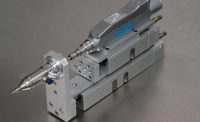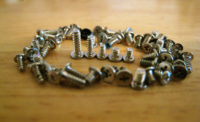"It’s a Small World” is one of the most popular attractions at Disneyland and Disney World. The same phrase also applies to the manufacturing world these days.
With the proliferation of portable electronics, threaded fasteners are getting smaller and smaller. So, too, is the automated equipment to install them. Precision screwdrivers are now available to apply torque as low as 3 in-oz.
As fasteners get tinier, they present big feeding and driving challenges to engineers. “Small” screws are typically defined as the diameter where the assembly time for a typical screw configuration starts to increase.
“Generally, assembly times decrease with decreasing diameter,” says Dave Archer, president of Archetype Joint LLC. “I would estimate that this reversal starts at #4 (3 millimeter) fasteners on average. Whether manual or automated assembly, the greatest challenge is usually engaging the bit with the drive feature and maintaining that engagement while driving the screw.”
“Small screws are defined by their size—typically 3 millimeter and smaller,” adds Mike Abbott, business development manager at Stanley Engineered Fastening. “I further define ‘miniature screws’ to be in the 3 millimeter down to about 1.6 millimeter size range and ‘micro screws’ as 1.4 millimeter down to 0.6 millimeter or smaller.”
“Another way to define or identify a small screw is the torque required to fasten it,” explains Boris Baeumler, applications engineer at DEPRAG Inc. “Screws with a 0.4 millimeter shaft may literally disappear underneath a fingernail when trying to pick them out of a bin. When the screw is too small to be [manually handled], it is suited to equipment we specifically design for small screws.
“We are seeing an increase in the demand for micro screw assembly solutions,” adds Baeumler. “Within the electronics and medical industries, there are countless new products that require small screws. As long as the screw has a shank diameter in a range that can be processed, then we can develop a solution.”
Tiny screws are used in a wide variety of applications in the consumer electronics and medical device industries. For instance, they’re found in camera lenses, cell phones, e-readers, hard drives, hearing aids, laptop computers, microscopes, orthopedic implants, pacemakers and watches. Other applications include hand tools, sunglasses and toy trains.
“The continued consumer-driven miniaturization of products is expanding the amount of micro manufacturing,” notes Jarrod Neff, marketing manager at Visumatic Industrial Products Inc. “Defense contractors [are also squeezing] greater functionality into compact tactical deployment envelopes.”
“Weight reduction initiatives in the automotive industry [also] continue to drive demand for smaller, more complex components, and with it, the need for smaller screws and fasteners,” says Gene Simpson, vice president of quality and engineering at Semblex Corp.
Compared to larger fasteners, miniature screws are difficult to handle, visually inspect and sort. Typical tolerances and feature sizes are also much smaller, requiring unique measurement methods, tools and assembly processes.
In addition, small screws tend to have short lengths. “A screw length that is less than 1.5 times the head diameter doesn’t orient itself well, which makes it difficult to feed, locate and pick up,” warns Abbott.
“Handling small screws is not only visually difficult for operators, but physically difficult, too,” Abbott points out. “This work requires precision and lends itself best to operators with small hands, small tools and very good eyesight, including visual aids such as magnifying glasses and microscopes.” That’s why many manufacturers are forced to use automated assembly equipment.
Feeding Challenges
Orienting, presenting, picking and placing tiny screws often create unique challenges. For instance, blow feeding can create problems because the screws often want to tumble or bind in the feeder tube.
“We have seen all types of feeding with small screws,” says Neil Maniccia, global product group manager for ASG Precision Fastening, a division of Jergens Inc. “We primarily have products which use vacuum pick up in conjunction with either a shaker box or screw presenter technology. Our technology is a variation of sword or drum technology.”
Sometimes, engineers need to consider other feeding options, such as pick-and-place equipment or vibratory bowls. “We [typically specify] vibratory bowls, as we can fill and grind all gaps [without] giving the parts any place to hang up on or stick to,” notes Greg Pflum, president of Performance Feeders Inc. “Vibratory bowls also give us more options for tooling to correctly orient the parts.
“The transfer point of the bowl to the gravity track or vibratory inline can be a problem area, due to the small screw size, including length and diameter,” explains Pflum. “Dirt holes also need to have attention paid to them to prevent good parts from getting stuck in them.
“We typically look at using a scarfed or tongue in groove transfer point so that you do not have a straight gap between the two transfer points,” adds Pflum. “Another option is to have the bowl discharge higher than the track running surface and overlap them, so you drop the parts into the track, eliminating the gap problem. For dirt holes, we look at small slots or open areas where we hang the parts to [avoid] holes for the screws to get caught in.”
One of the biggest challenges when feeding small screws is the overall length-to-head diameter ratio. “The closer that ratio is to 1-to-1, the more difficult it becomes to maintain the correct orientation of the screw in the feed escapement mechanism,” claims Vic Glenn, president of Design Tool Inc.
“With smaller screws, the tolerances of the feed components must be held more closely (tighter) to ensure that the mechanism will function correctly,” says Glenn. “Some small screws are difficult to orientate in the bowl before entering the feed mechanism because of the weight and size of the head.
“[We are] addressing the challenge of feeding smaller screws with custom designs of our feed systems, including slide systems that control the screw until it is released into the feed tube,” Glenn points out. “Our patented feed systems are very adaptable for smaller screw applications.”
Design Tool typically uses vibratory feeder bowl systems for small screws. However, the scale of the feed orientation and escapement components becomes smaller with small screws.
“The primary challenges in driving small screws with an auto feed system are maintaining the correct screw orientation within the screwdriver components and clearance around the screw head for the driver components to access locations in the customer’s assembly parts.
“Our driver components can be designed to fit into small areas and still allow the screw to exit the driver,” claims Glenn. “Also, we offer different types of drivers that enable us to successfully drive most small screw applications.”
Whether a screw is steel, brass or plastic, the same basic feeding techniques typically apply. If a screw can’t be blow-fed, vacuum is the preferred pick-up solution.
However, the type of material a screw is made of can affect the type of automation that can be used. For example, nonferrous material will require vacuum solutions instead of pick-up tools that incorporate magnets.
“As ferrous screws get smaller, the behavior of magnetic tooling is more inconsistent,” says Baeumler. “In most cases, vacuum tooling or mechanical gripping would be used to manipulate the smaller screws if blow feeding is not an option. But, even the slightest magnification amongst the screws can disrupt the screw sorting and movement. [That’s why] our smallest feeder uses a piezo driver rather than an electromagnet drive.”
Driving Issues
Small screws pose several driving challenges. For example, orienting a screw to the driver bit, holding it in place, and then driving the screw to its correct assembly torque can cause headaches for engineers. Screwdriver end-load, speed and shut-off are critical to driving and controlling assembly torque.
“Stripping, cross threading and driver cam out are all challenges,” says Leon Attarian, director of global marketing at PennEngineering. Other issues that must be addressed include thread pitch, head diameter, head height, overall length, diameter of the screw and application access.
“While we do offer small screws, we encourage our customers to reduce the amount of loose hardware, including screws, in their assemblies,” notes Attarian. “Our new self-clinching fastener will replace screws in many applications.”
With small screws, the competence of the screw supplier is critical. Tight tolerances are essential.
According to Visumatic’s Neff, platings and coatings, such as lubricants and organophosphate coatings, can limit automation options available to engineers.
“There can also be quite a bit of frictional variation between contact surfaces during joining which often gets exaggerated by imperfections, especially in low-cost materials,” warns Neff. “Sometimes, just one extra thread can make all the difference in achieving repeatable screw drives.”
“The screwdriver also has to offer the required torque range and high shut-off accuracy,” claims Baeumler. “A tiny screw will not allow for a big tolerance window in terms of torque, as the chances are high that the screw or the product may fail.
“All in all, small screws demand a total view on the assembly task,” Baeumler points out. “The challenges must not be underestimated and can be extensive.
“Extra consideration has to be given to ensure that the end tooling and the drive bit are perfectly aligned for repeatable insertion and that the low torque values are accurately applied,” Baeumler points out. “The tolerances in the driveline of the standard industry screwdriver [are not conducive to] driving small screws and have to be compensated using ‘add on’ techniques in many cases.”
For very small screws, Baeumler says the industry standard 0.25-inch hex drive may not be viable due to the tolerance implications toward the axial bit position and, more importantly, the torque accuracy required in such a low range. “The bit tip design and accuracy have to be suited for small screws and made extremely accurate,” he claims.
DEPRAG has addressed those challenges by developing micro- and nano-sized screwdrivers that are the size of a ballpoint pen. The NANOMAT is a pneumatic screwdriver with mechanic shut-off clutch. The NANOMAT-EC is a current-controlled screwdriver that features torque and angle monitoring, and joint analysis functions.
Web exclusive
Avoid These Mistakes With Small Screws









